I recently shared a crick neck inducing chart visualizing the percentage of app marketplace listings that earned 1 or more reviews in leading App Marketplaces, including Atlassian, Shopify, HubSpot, and Xero.
Based on the LinkedIn thread that followed, the chart surprised a lot of people. I made the chart, and it certainly surprised me.
Here's a less crick neck inducing version.
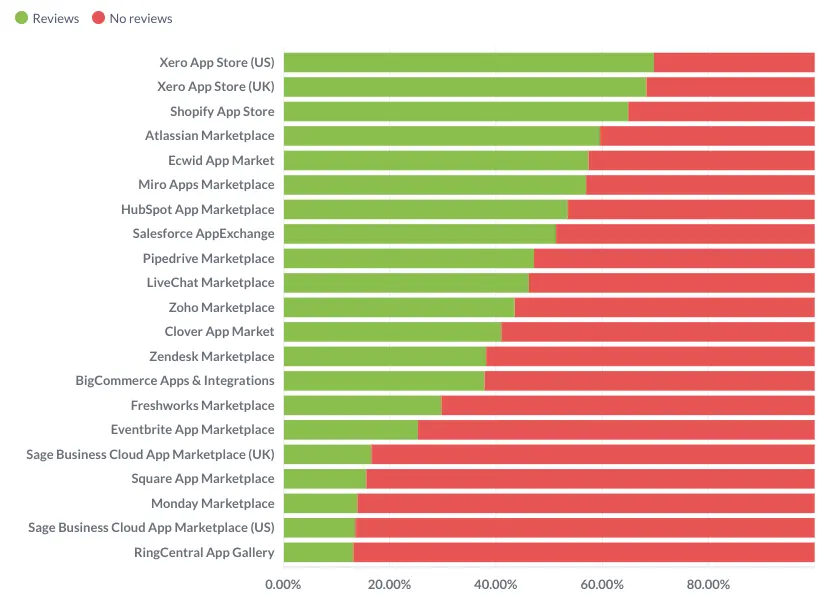
ISV partners in Atlassian, Shopify, and Xero's App Marketplaces clearly cracked the reviews code. 60-70% of listings in these marketplaces earned 1 or more product reviews.
Which means a majority of customers that installed and used partner-built products had an opinion about their experience - good, bad, or indifferent - strong enough to share. Pretty good.
At the low end - this is not a typo - just 13% of listings earned any reviews. This 13% isn't the listings with "good" or "bad" reviews. Just listings with 1 or more reviews.
Which means a majority of current and potential customers - 87% of them - had no opinion at all to share about partner-built products listed in these marketplaces. Not exactly amazing.
But that's not the full story. Not even close.
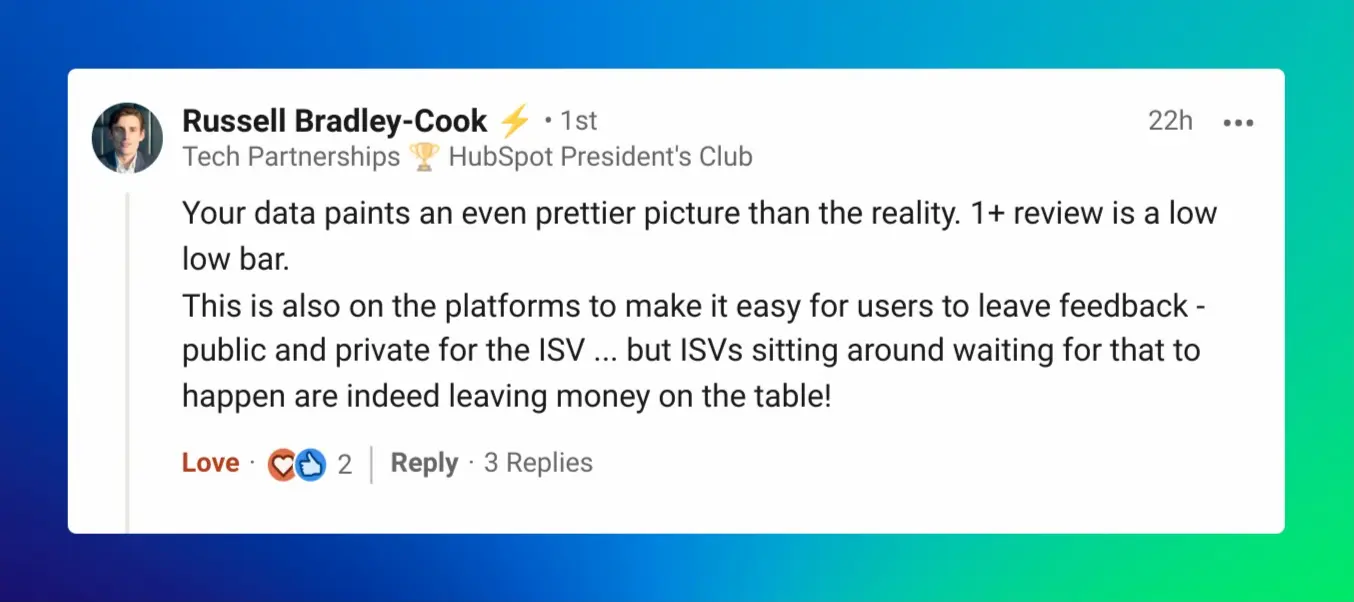
In the aforementioned LinkedIn comment thread, Russell Bradley-Cook - a Senior App Partner Manager at HubSpot - made a very interesting and very valid point: 1+ reviews is a low, low bar.
So, with that in mind, let's look at the distribution of listings with 10+ reviews.
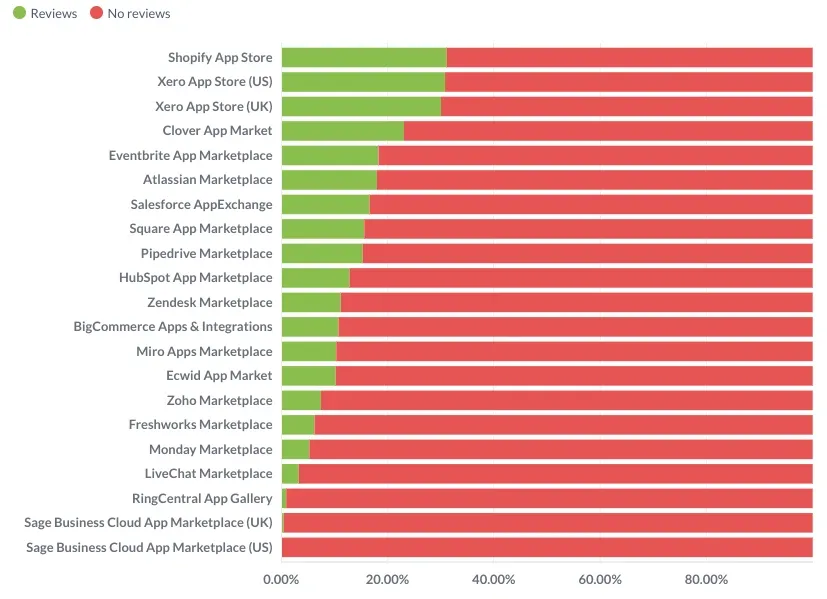
Wow. Quite a difference. And definitely not in a good way.
At the high end - Shopify and Xero - just over 30% of listings in their marketplaces earned 10 or more reviews. Not bad, especially since they count the number of paying customers they have in millions. Not super great, either.
That said, bearing in mind Shopify lists 18 times the number of listings in their marketplace compared to Xero, it does counter the argument that Shopify App Store is "saturated." Even with over 11,000 listings to compete with, the head and torso are doing reasonably well.
Yet, for a third of marketplaces, less than 10% of listings earn 10 or more reviews.
For platforms, partners, customers, and potential buyers, that's a massive missed opportunity.
Marketplace reviews are a route to revenue
What, if anything, explains the gap?
Are platforms not doing enough to promote reviews of partner products? Are partners not doing enough to create their own feedback loops and "nudge" customers to write reviews? Do marketplace users even care about reviews?
Let's start with the last question first.
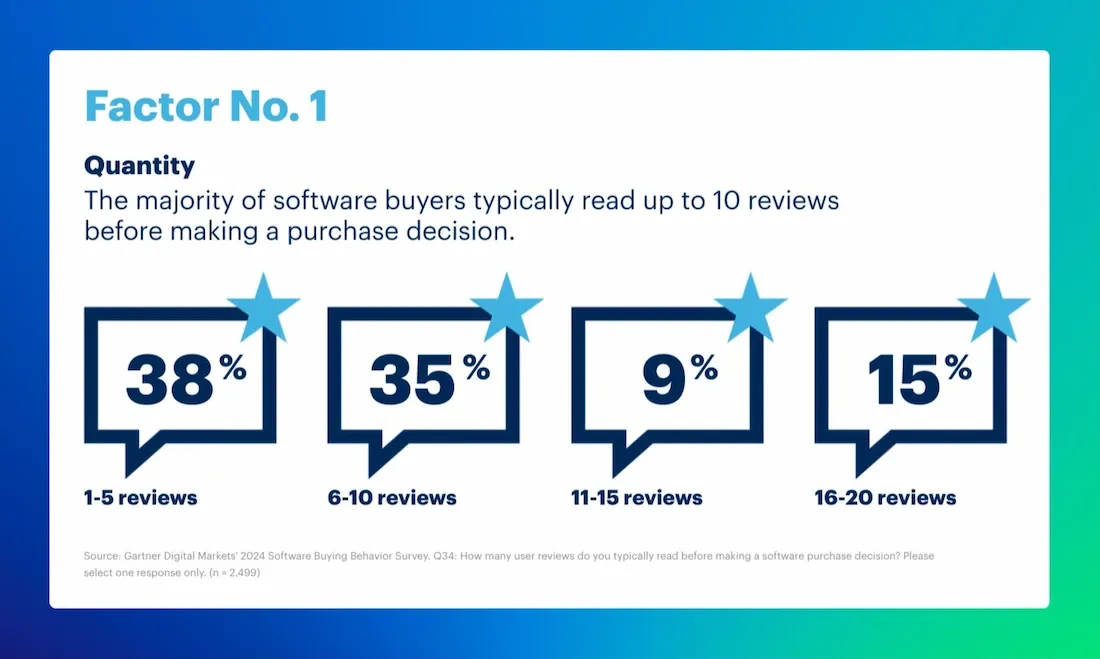
According to Gartner, 98% of software buyers say reading reviews before making a purchase is important. The majority of them read up to 10 reviews before making a buying decision. Buyers value relevancy and recency from reviews: 92% of buyers trust software reviews written within the past year.
So, yes, software buyers care about reviews. A lot.
Reviews aren't just "feedback" - they create value in three unique ways.
Trust
Reviews, first and foremost, are a tool to accelerate the trust building process with potential buyers. SaaS buyers don't want just any old products - they want legit products they won't get fired for buying. They need to know the product they're being sold is the actual product they'll receive. Reviews contain the knowledge they need to build that trust.
Buyers trust vendor sales reps the least. They trust recommendations - reviews - from friends and peers the most. Because (sorry, reps) friends and peers have nothing to lose by speaking the truth about their experiences - good or bad.
Building trust removes friction from the buying process.
Installs
Traffic and leads aside, install growth is the metric that matters most, for most listings in most marketplaces. When optimized well, listings educate potential customers about the value of apps and integrations, explain how they work, and nudge customers towards installing them.
If marketplace listings are steps in a funnel, installs are right in the middle of that funnel.
The act of installing an app or integration signals strong intent from potential buyers. When potential buyers click "install" they're already exchanging value - data and time - with the product they're evaluating.
That's a huge, often undervalued, step.
When products and listings are optimized well, install growth often correlates with review growth. More users installing means more people reviewing, right? Not always.
A well optimized user journey will bring potential buyers down a clear path towards trying and buying a product. They expect to get value before they give value - money - back to the creator of the app or integration.
Listings with large number of installs - but no reviews - are a strong signal the app or integration doesn't create much value, or doesn't do anything at all. These types of apps and integrations, unfortunately, are all too common.
They're usually created with the wrong immediate goal in mind.
Revenue
The ultimate goal of every business - every healthy one at least - is to generate revenue. It's the oxygen every company needs to grow, prosper, and survive. Every SaaS business building (and listing) apps and integrations cares about this metric the most.
But it's much harder to move this metric in the right direction without building trust and growing installs first. This is where so many ISV partners go wrong - they try to put the revenue cart before the trust and installs horse.
It's one reason why marketplace review adoption is much lower than it should be.
It's also why ISV partners so sometimes say "marketplaces don't work for us."
Here's the thing: if App Marketplaces "work" for SaaS businesses like QuotaPath, and OrgChartHub (and thousands more developers in larger ecosystems like Shopify), they should "work" for any SaaS business. Large or small. Venture backed or not.
But partners like QuotaPath and OrgChartHub have no option but to start by building trust first. Because they aren't well known brands, and don't have big brand budgets.
They don't have the option, or the privilege, of even trying to put the revenue cart before the horse. If they don't have a strong product, and can't concretely articulate the value the product creates, they have nothing else left to lean on.
How to earn trust (and reviews)
Remember I mentioned buyers want legit products? Earning trust and reviews begins here. The partners I mentioned earlier - OrgChartHub, and QuotaPath - don't just position their products as legit.
They are legit.
Their product and engineering teams build apps and integrations that integrate deeply with the platforms they and their customers care about.
The legit-ness of these products creates trust and generates the best reviews. Check out this recent review of OrgChartHub from a new customer, Hatfaludi.
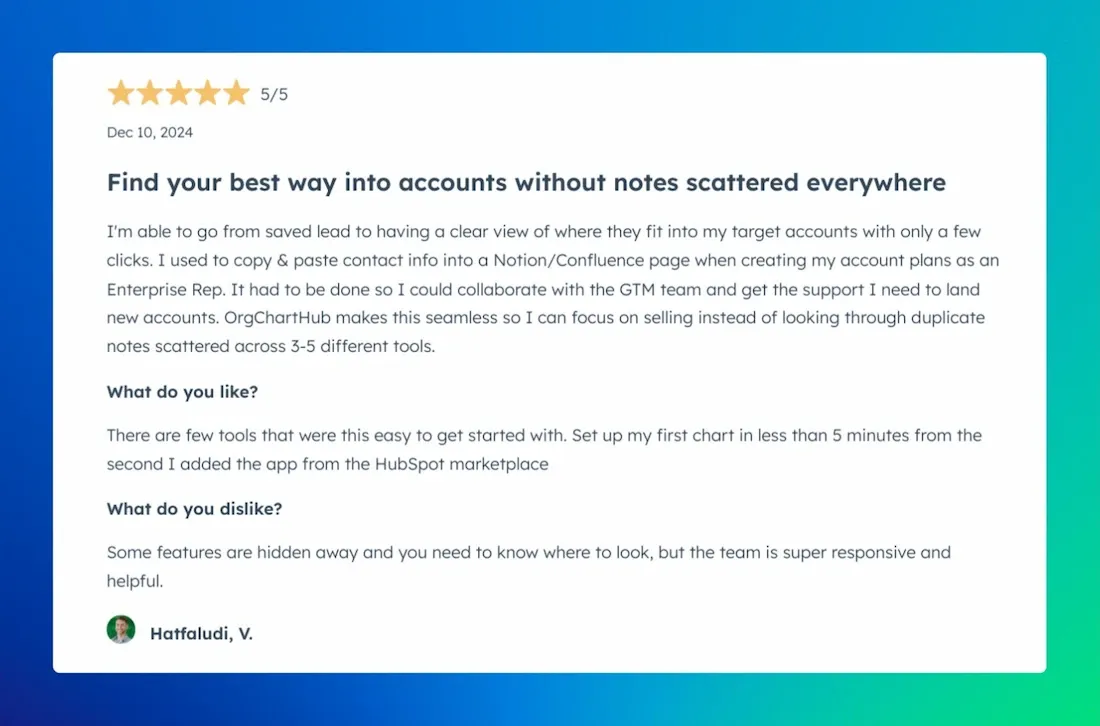
This quote is the best advertising OrgChartHub could ever wish for:
"Set up my first chart in less than 5 minutes from the second I added the app from the HubSpot marketplace."
The trust building process with Hatfaludi started when he discovered and read OrgChartHub's marketplace listing. That trust built even further when - once Hatfaludi had installed it - the OrgChartHub product delivered exactly what was promised.
Hatfaludi's experience - built on trust and an install - quickly converted into revenue.
And now, through his review, Hatfaludi is sharing his trust with other potential buyers.
For OrgChartHub's founders, Dan and Austin, the trust building process doesn't end there. Every review, regardless of the content or the opinions expressed in it, is responded to. In Dan's own words:
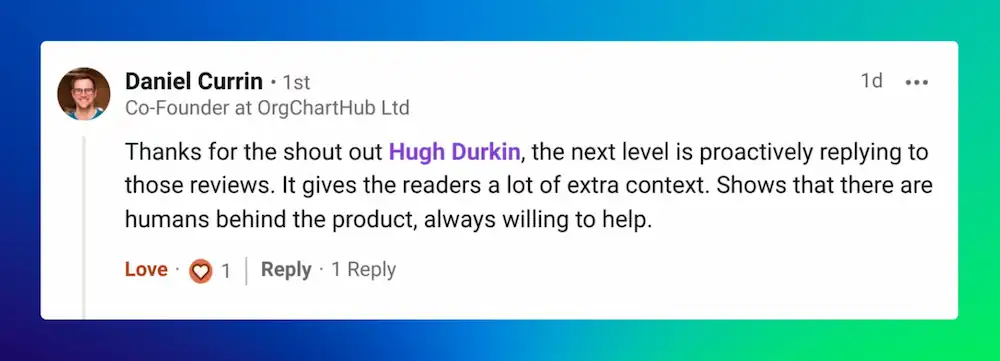
How not to earn trust (or reviews)
In stark contrast, take a moment to visit your favorite marketplace that offers ratings and reviews. Search for the names of well known, well funded software products and platforms you're most familiar with. I bet you're seeing what I'm seeing.
Listings with an average rating of two or three stars. Or, in some cases, worse than that.
You're probably also seeing vast amounts of customer feedback - reviews - containing feedback gold that could, and should, be acted upon to improve products, pricing, and more.
You're probably also noticing these reviews - when they exist - lack any response.
The listings without any reviews are the most worrisome of all.
I'll bet many of the reviews you see tell stories about integrations that are "limited" or "painful" or - worst of all - "useless." I didn't choose these words. They're real words written by real customers about an integration built by a market leading software company (no, I won't name names).
These are fair, accurate ratings, each written by a real person. Yet, they're ignored.
Quick tips to manage reviews
Listings, for most ISVs in most App Marketplaces, represent missed opportunities to build trust, earn installs, and drive revenue. Opportunities smart ISVs can capitalize on.
Only 15% of App Marketplace listings earn 10 or more reviews. Which means - with a little time and effort - any SaaS business can quickly and easily stand out from 85% of their competitors and peers.
Simply by engaging with and learning from their customers.
And, with a sprinkling of AI, it's easier than ever to get started. Here's some quick tips to manage marketplace reviews the easy way.
Know what's being said, and when
Many App Marketplaces send notification emails when new reviews are posted. But, for those that don't, free tools like Wachete can "watch" pages for you, letting you know when content changes and reviews are added. Just don't forget to act on and respond to reviews as soon as you know about them.
AI to understand
Reviews come in many formats and many languages. Some are shorter than others. Some are angrier than others. But most contain nuggets of feedback gold. Copy/paste the content of them into tools like ChatGPT, and use these tools extract sentiment, themes, and actions from every review. Then, store that insight gold in a safe place - a shared doc, a backlog, whatever.
But don't let it sit there - do something about it.
AI to reply
Tools like ChatGPT can also help you reply to reviews - especially the not-so-great ones. LLMs are good at understanding the sentiment and tone of reviews, and are pretty great at drafting balanced responses that may not resolve issues, but could help you turn low ratings into better ones.
Simply by engaging with and acknowledging customer feedback.
Benchmark and improve
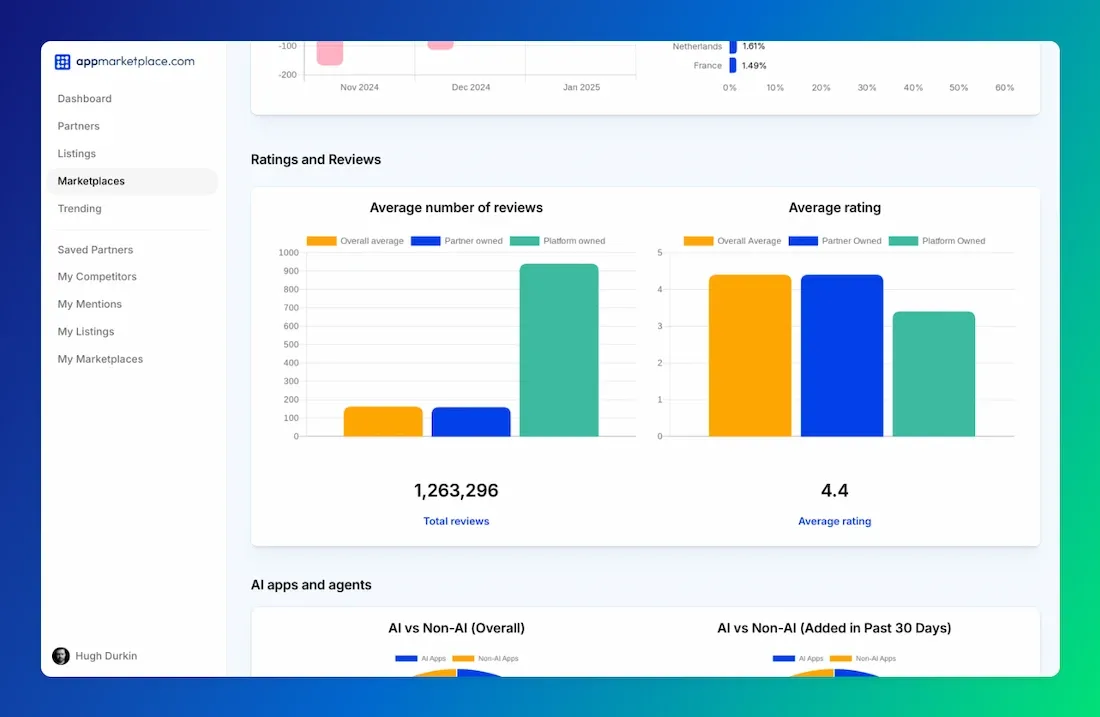
Establish review benchmarks for every App Marketplace you compare about, and every competitor you care about. Aim to be better than average. Monitor new competitors as soon as they get listed in the marketplaces you care about (appmarketplace.com Pro monitors competitors and marketplaces for you).
Make marketplace reviews your unfair advantage
Start this year - and every year - by making marketplace reviews a core part of your ISV partner strategy. And take time to measure the effort and impact of them. In the wonderful words of Peter Drucker "what gets measured gets managed."
Treat marketplaces, and reviews within them, like every other channel you care about. A one-and-done approach won't work well for any other channel, so don't assume it will for App Marketplaces.
A little effort can go a long, long way.





